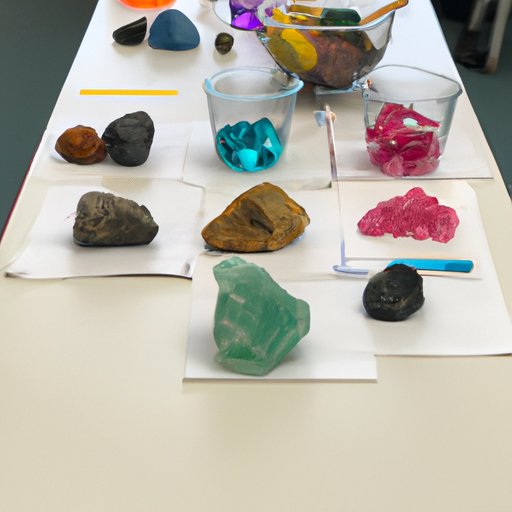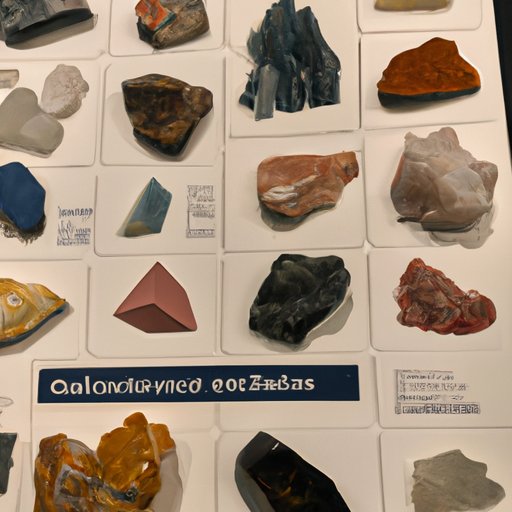Introduction
Minerals are naturally occurring substances that form part of the Earth’s crust. They are essential for life and are found in food, water, and air. Minerals can also be found in many products, such as cosmetics, jewelry, and paint. While some minerals are used as is, others are processed to create various products. In order to understand the importance of minerals, it is important to know what they are and the different types of minerals that exist.
A Comprehensive List of Examples of Minerals
Minerals are classified into two main categories: common minerals and rare minerals. Common minerals are abundant and widely distributed, while rare minerals are less common and usually have a more limited distribution. Below is a list of examples of minerals from both categories.
Common Minerals
Common minerals include feldspar, quartz, mica, amphibole, olivine, calcite, dolomite, and gypsum. Feldspar is a silicate mineral that is found in igneous, sedimentary, and metamorphic rocks. Quartz is a hard, crystalline mineral that is often used in jewelry and watches. Mica is a group of silicate minerals with a layered structure. Amphibole is a group of dark-colored minerals that contain iron and magnesium. Olivine is a greenish mineral that is found in igneous rocks. Calcite is a carbonate mineral that is often used in cement and mortar. Dolomite is a carbonate mineral that is composed of calcium and magnesium. Gypsum is a soft, white mineral that is used to make plaster of Paris.
Rare Minerals
Rare minerals include diamond, ruby, sapphire, emerald, topaz, tourmaline, kunzite, and turquoise. Diamond is the hardest naturally occurring mineral and is often used in jewelry. Ruby and sapphire are both varieties of the mineral corundum and are used as gemstones. Emerald is a variety of the mineral beryl and is prized for its deep green color. Topaz is a silicate mineral that is often used in jewelry. Tourmaline is a group of minerals that come in various colors and are used as gemstones. Kunzite is a pink variety of the mineral spodumene and is used as a gemstone. Turquoise is a blue-green mineral that is often used in jewelry.

Exploring the Properties and Uses of Various Minerals
Minerals have unique physical and chemical properties that make them useful in a variety of applications. Physical properties include color, crystal form, hardness, streak, and luster. Chemical properties include composition, reactivity, and solubility. Minerals are used in a wide range of industries, including construction, manufacturing, electronics, and agriculture. For example, limestone is used in cement production, quartz is used in the manufacture of glass, and aluminum is used to make aircraft parts.
The Benefits of Incorporating Minerals Into Your Diet
Minerals are essential nutrients that play a key role in maintaining good health. They help to build bones and teeth, regulate body temperature, and support nerve and muscle function. Eating a balanced diet that includes a variety of minerals can provide numerous nutritional and medicinal benefits. Vitamin and mineral supplements may also be beneficial for those who do not consume enough minerals through their diet.
How Minerals Impact Our Health and Well-Being
Minerals are vital for healthy functioning of the body. They are involved in many processes, such as energy production, growth and repair of tissues, and regulation of hormones. Deficiencies or excesses of certain minerals can lead to health problems, such as fatigue, weakness, and bone loss. It is important to ensure that you are getting enough of the essential minerals in your diet.

An Introduction to Rocks and Minerals
Rocks and minerals are both naturally occurring materials, but they are not the same. Rocks are made up of several minerals that are bound together, while minerals are homogenous substances that occur naturally. Rocks can be found on the surface of the Earth and in various layers of the Earth’s crust. Minerals, on the other hand, are found in rocks, soil, water, and air.

Examining the Unique Characteristics of Minerals
Minerals have distinct characteristics that make them easily identifiable. Color is one of the most obvious characteristics of minerals. Other characteristics include crystal form, hardness, streak, and luster. Hardness is a measure of a mineral’s resistance to being scratched or broken. Streak is the color of a mineral’s powder when it is rubbed on a porcelain plate. Luster is the way light reflects off the surface of a mineral.
Conclusion
Minerals are an important part of our lives and are essential for maintaining good health. They are found in rocks, soil, water, and air, and have unique physical and chemical properties that make them useful in a variety of applications. Minerals can provide numerous nutritional and medicinal benefits, and it is important to ensure that you are getting enough of the essential minerals in your diet. By understanding the different types of minerals, their properties, and their uses, we can better appreciate their importance and value.
(Note: Is this article not meeting your expectations? Do you have knowledge or insights to share? Unlock new opportunities and expand your reach by joining our authors team. Click Registration to join us and share your expertise with our readers.)
